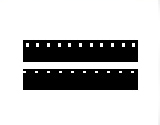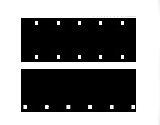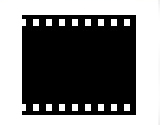

8mm, Super 8, 16mm Frequently Asked Questions (FAQs)
-
8mm/Super 8 Film
-

-
16mm Film
-

-
35mm Film
-

8mm Film & Super 8 Film FAQ |
|
| What resolution can you scan 8mm or Super 8 film at? |
We can scan 8mm and Super 8 from from at 480 line (standard definition), 1080 lines (high definition) and 1556 lines (2K) |
| How do I calculate how many feet of 8mm or Super 8 film I have? |
It's pretty easy. You just need to measure the reel diameter. They have 3" diameter reels (50ft), 5" (200ft), 6" (300ft) and 7" (400ft). We only charged based on actual content. So, just enter the estimated footage on the order form. We will bill you based on the actual footage with content. |
| Is there a difference between an SD and HD scan for 8mm film? |
Yes. There is a huge difference between an SD (480 line) scan and a HD (1080 line) scan. The reason is that 8mm and Super 8 film have around 800 to 1000 lines of resolution. We've seen some film come in at lower resolution and we've seen some film come in at around HD resolution. So, an SD scan of film at 480 lines will only get about 50-60% of the details from the film. |
| Is there a difference between an HD and 2K scan for Super 8 film? |
In theory there shouldn't be over 1080 lines of resolution on 8mm or Super 8 film. But, what you find in practice sometimes is different than theory. One thing to keep in mind is that any scanner, no matter how good, will loose some resolution in the scanning process. Meaning, there is always some loss. Cheaper machines loose more. More expensive scanners loose less. We ran 25 tests between our Pro HD and Pro 2K process. In 24 of 25 we noticed a ~25% difference in definition and dynamic range between the Pro HD and Pro 2K. The one that didn't show a difference had film that was a little out of focus. So, it couldn't take advantage of the additional resolution of the 2K scan. So, 25% isn't earth shattering but it is a difference. Those looking for the best should consider the Pro 2K scan. |
| Can you convert 8mm or Super 8 with sound? |
Yes. We can scan both 8mm with sound and Super 8 with sound. We can also get single to double track sound from 8mm or Super 8 film. 8mm film was never commercially made with a sound strip but some people added their own sound strip. |
| Can I get digital video files from my 8mm film conversion instead of DVD or BluRay? |
Yes. In fact you can order up to 3 different formats from us at the time of order. As far as digital video files go, you can order standard definition AVI or MOV files, high definition Apple ProRes or HD-AVI files or 2K DPX files. |
| Can I provide my own hard drive for my film conversion? |
Yes. We only ask that you format the drive so that it is empty. |
| Does a 3 inch reel have 25 or 50 feet? |
Some of the 8mm Kodak yellow boxes say 25 ft on them and it can be confusing because there is actually 50 feet on these reels. Most of the boxes actually say 25ft of a double roll. Usually the words "double roll" will be right under "25ft" or might be on the other side of the box. You shot one side of the 25 foot roll and then took the cartridge out, turned it over, put it back in and shot the other side of 25 foot roll. Kodak then split the 25 feet of 16mm film into one 50 foot roll of 8mm film. So, this is why the 3" reels have 50 feet on them even though the box might say 25ft of a double roll. |
| What other formats do you offer besides 8mm film to DVD? |
We can transfer your 8mm or Super 8 film to DVD, BluRay, MOV, AVI, HD ProRes, HD-AVI and DPX. |
| Can you transfer 8mm or Super 8 film with damaged sprocket holes? |
In most cases, yes. Our professional line of equipment (Pro SD, Pro HD, Pro 2K) are roller based scanners. They don't use the sprocket holes to move the film through. The equipment can deal with up to 12 consecutive missing sprocket holes. |
| Can you improve or restore my 8mm or Super film? |
Yes. We specialize in high resolution scanning of movie film and in restoring movie film. We can color and exposure correct your 8mm or Super 8 film and can also remove grain and stabilize the image. |
| I heard that frame by frame equipment is the best for 8mm or Super film scanning. Is that true? |
No. Frame by frame equipment is the only non-professional film scanner we use. It uses a modified projector and camcorder setup. Not too much more sophisticated than you could do at home. The reason some people think it is the best is because other companies tell them that is what they use and that it is the best. It is far from the best. A frame by frame machine costs around $3000. Our professional film scanners range from $100,000 to $350,000. They produce video from film that is significantly better compared to a frame by frame machine. |
16mm Film FAQ |
|
| What resolution can you scan 16mm film at? |
We can scan 16mm from from at 480 line (standard definition), 1080 lines (high definition) and 1556 lines (2K) |
| How do I calculate how many feet of 16mm film I have? |
It's pretty easy. You just need to measure the reel diameter. They have 3" diameter reels (50ft), 4" (100ft), 5" (200ft), 6" (300ft) and 7" (400ft), 8" (600ft), 10" (800ft), 12" (1200ft), 15" (2000ft). We only charged based on actual content. So, just enter the estimated footage on the order form. We will bill you based on the actual footage with content. |
| Is there a difference between an SD and HD scan for 16mm film? |
Yes. There is a huge difference between an SD (480 line) scan and a HD (1080 line) scan. The reason is that 16mm film have around 1500 lines of resolution. We've seen some film come in at lower resolution and we've seen some film come in at around 2K resolution. So, an SD scan of film at 480 lines will only get about 25-30% of the details from the film. An HD scan will get about 60% of the details from the film. |
| Is there a difference between an HD and 2K scan for 16mm film? |
Yes. An HD 16mm scan will get about 60% of the details from the film since the film is capable holding about 1500 lines (2K). A 2K scan will get 100% of the details and dynamic range of the film. So, a 2K scan will look about 40-50% better in terms of detail and dynamic range. |
| Can you convert 16mm with sound? |
Yes. We can scan both 16mm composite magnetic and optical sound. We can also get single to double track sound from 16mm film. However, sometimes the sound was put on it's own full coat magnetic reel/hub. We unfortunately cannot scan full coat magnetic sound at this time. |
| Can I get digital video files from my 16mm film conversion instead of DVD or BluRay? |
Yes. In fact you can order up to 3 different formats from us at the time of order. As far as digital video files go, you can order standard definition AVI or MOV files, high definition Apple ProRes or HD-AVI files or 2K DPX files. |
| Can I provide my own hard drive for my film conversion? |
Yes. We only ask that you format the drive so that it is empty. |
| Does a 3 inch reel have 25 or 50 feet? |
The smallest 16mm film reel ranges from about 2.5 inches to 3 inches. These have 50 feet on them. There was also what we call a 4" reel that had 100 feet (actually measured about 3.5" to 4" in diameter). |
| What other formats do you offer besides 16mm film to DVD? |
We can transfer your 16mm film to DVD, BluRay, MOV, AVI, HD ProRes, HD-AVI and DPX. |
| Can you transfer 16mm film with damaged sprocket holes? |
Yes. Our professional line of equipment (Pro SD, Pro HD, Pro 2K) are roller based scanners. They don't use the sprocket holes to move the film through. The equipment can deal with up to 12 consecutive missing sprocket holes. |
| Can you improve or restore my 16mm? |
Yes. We specialize in high resolution scanning of movie film and in restoring movie film. We can color and exposure correct your 16mm film and can also remove grain and stabilize the image. |
| I heard that frame by frame equipment is the best for 16mm film scanning. Is that true? |
No. Frame by frame equipment is a non-professional film scanner. It uses a modified projector and camcorder setup. Not too much more sophisticated than you could do at home. The reason some people think it is the best is because other companies tell them that is what they use and that it is the best. It is far from the best. A frame by frame machine costs around $4000. Our professional film scanners range from $100,000 to $350,000. They produce video from film that is significantly better compared to a frame by frame machine. |
35mm Film FAQ |
|
| What resolution can you scan 35mm film at? |
We can scan 35mm from from at 480 line (standard definition), 1080 lines (high definition) and 1556 lines (2K) and 3112 (4K). |
| How do I calculate how many feet of 35mm film I have? |
It's pretty easy. You just need to measure the reel/hub diameter. They have 3" diameter reels (50ft), 4" (100ft), 5" (200ft), 6" (300ft) and 7" (400ft), 8" (600ft), 10" (800ft), 12" (1200ft), 15" (2000ft). We only charged based on actual content. So, just enter the estimated footage on the order form. We will bill you based on the actual footage with content. |
| Is there a difference between an SD and HD scan for 35mm film? |
Yes. There is a huge difference between an SD (480 line) scan and a HD (1080 line) scan. The reason is that 35mm film have around 3000 lines of resolution. We've seen some film come in at lower resolution and we've seen some film come in at around 4K resolution. So, an SD scan of film at 480 lines will only get about 1/6th of the details from the film. |
| Is there a difference between an HD and 2K scan for 35mm film? |
Yes, especially for 35mm film. An SD scan is 480 lines while an HD scan is 1080 lines. 35mm film have around 3000 lines of resolution. We've seen some film come in at lower resolution and we've seen some film come in at around 4K resolution. So, an HD scan of 35mm film will only get about 1/3 of the details from the film. A 2K scan will get about 2/3 of the details from the film. |
| Can you convert 35mm with sound? |
Yes. We can scan both 35mm with composite magnetic and optical sound. However, sometimes the sound was put on it's own full coat magnetic reel/hub. We unfortunately cannot scan full coat magnetic sound at this time. |
| Can I get digital video files from my 35mm film conversion instead of DVD or BluRay? |
Yes. In fact you can order up to 3 different formats from us at the time of order. As far as digital video files go, you can order standard definition AVI or MOV files, high definition Apple ProRes or HD-AVI files or 2K/4K DPX files. |
| Can I provide my own hard drive for my film conversion? |
Yes. We only ask that you format the drive so that it is empty. |
| Does a 3 inch reel have 25 or 50 feet? |
35mm film was usually shot in 400 foot or 1000 foot rolls. There generally wasn't anything smaller. So, there are no 3 inch 35mm reels/hubs unless one of the 400/1000 foot rolls was edited. |
| What other formats do you offer besides 35mm film to DVD? |
We can transfer your 35mm film to DVD, BluRay, MOV, AVI, HD ProRes, HD-AVI and DPX. |
| Can you transfer 35mm film with damaged sprocket holes? |
Generally no. Our 35mm 2K/4K scanner is pin registered. So, the sprocket holes have to be in good condition. Typically most 35mm film is still in the lab bag and is still in good condition. So, normally this is not a problem. |
| Can you improve or restore my 35mm film? |
Yes. We specialize in high resolution scanning of movie film and in restoring movie film. We can color and exposure correct your 35mm film and can also remove grain and stabilize the image. |
| I heard that frame by frame equipment is the best for 35mm film scanning. Is that true? |
No. Actually Frame by frame equipment refers to a modified projector and camcorder setup primarily used for 8mm and Super 8 film and in some cases 16mm film. They are not used for 35mm film scanning. Our professional 35mm film scanners range from $100,000 to $350,000. |

